
The New Facebook Algorithm: Secrets Behind How It Works and What You Can Do To Succeed
Too busy to read? Just click the play button below to listen to this post.

The Facebook algorithm is constantly evolving in order to provide a better experience for users.
But few changes to the algorithm have sparked as much interest and conversation as the recent ‘meaningful interactions’ update, in which Facebook said it would be prioritizing posts that create meaningful conversations, especially those from family and friends.
The reaction to this update was one of curiosity and worry from brands, publishers, and Facebook Page managers, wondering whether or not their organic reach would once again take a hit, causing them to reach an even smaller percentage of their audience on Facebook.
We were lucky enough to get an inside look at the brand new Facebook algorithm for 2018, directly from an exclusive News Feed webinar for publishers (thanks to Matt Navarra and Ned Berke).
Here’s everything we know about how the Facebook algorithm works and what marketers and brands can do to thrive on Facebook in 2018.
Let’s dive in!

How the Facebook algorithm and News Feed works (2018)
When a user visits Facebook, there are thousands of potential posts that might be displayed in their News Feed. The sophisticated algorithm takes these posts and arranges them according to how likely the user would be to interact with the content.
That’s the basic theory, at least. Let’s take an even deeper look.
In the recent Facebook News Feed webinar, their team broke the algorithm down into four, very simple components:
- Inventory (content available)
- Signals (considerations about content)
- Predictions (considerations about person)
- Overall Score
These four key algorithm factors serve the sole purpose of providing Facebook users with a better overall experience.
Signals are what we as brands and marketers can focus on in order to have our content seen by more users on the Facebook News Feed.
Previously, Facebook used all sorts of signals to determine which posts would be shown to users:

Now, the algorithm will use signals that heavily favor “active” interactions such as comments and shares:

One reason why Facebook will be prioritizing posts from family and friends over public content from Pages is that they believe a person-to-person connection is more valuable than a person-to-page connection.
In other words, content from friends and family tends to spark more “active” engagement from users.
As Alaura Weaver writes in her Medium article on the importance of story-driven content, “Instead of focusing on what makes content popular and attention-grabbing, we need to focus on what makes content personal and conversation-worthy.”
Understanding each of the top signals and ranking factors in the Facebook algorithm is the first step in creating content that ranks well.
Top ranking factors in the Facebook algorithm
When considering the types of content that Facebook will favor in the News Feed moving forward, it’s important to distinguish between “active” and “passive” interactions.
Active interactions such as sharing, commenting, and reacting will hold much more weight than “passive” interactions such as clicking, viewing, or hovering.
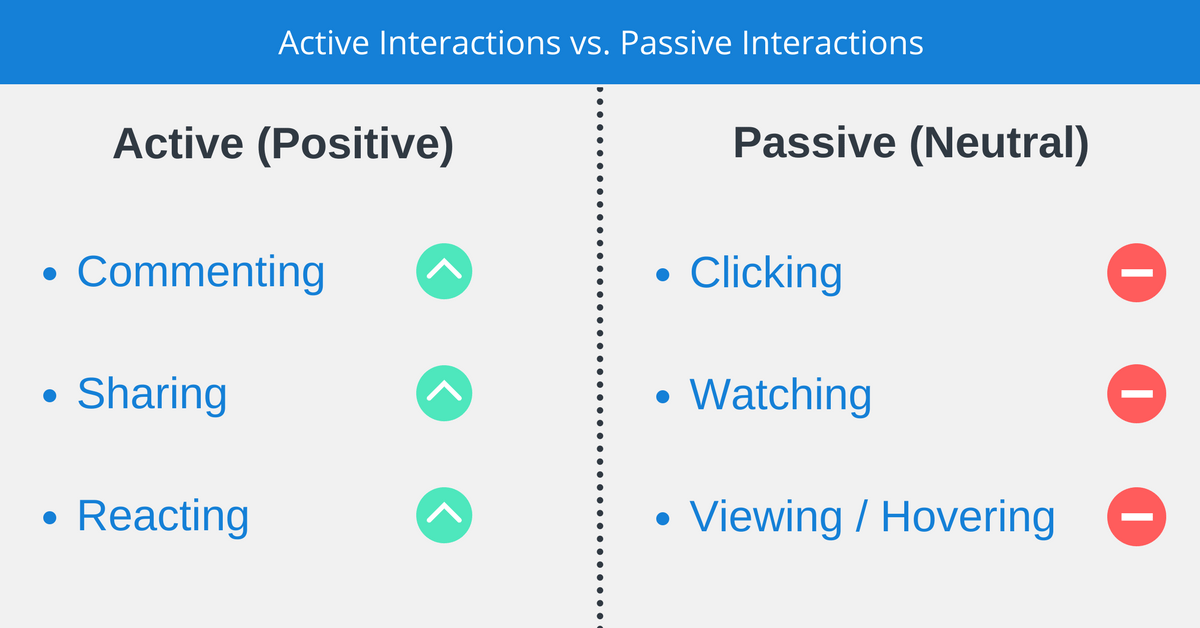
Let’s take a look at each active interaction in a bit more detail.
1. Commenting
The signal at the very top of the new Facebook algorithm in 2018 is comments.
As Adam Mosseri, Head of News Feed, wrote in a January press release:
“Page posts that generate conversation between people will show higher in News Feed. For example, live videos often lead to discussion among viewers on Facebook–in fact, live videos on average get six times as many interactions as regular videos”
However, it’s important to clarify that using “engagement bait” to goad people into commenting will actually result in a demotion of your posts in the News Feed.
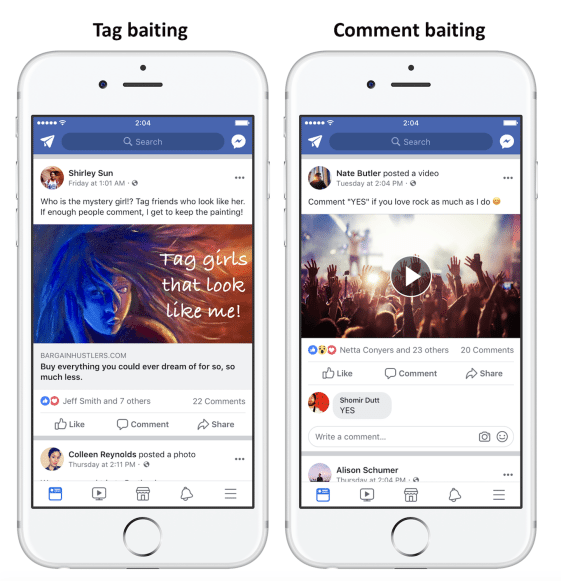
Facebook Page admins should continue to focus on posting relevant and meaningful stories that do not use engagement bait tactics. More on that later in the post!
2. Sharing
Directly behind commenting in the new Facebook algorithm for 2018 is sharing.
In the graphic above on “signals” you might have noticed that Facebook mentions two types of sharing:
- People sharing links or content within Messenger
- Engagement with a publisher post shared by a friend
In other words, Facebook is placing a great deal of emphasis on posts that are shared publicly as well as privately.
The other key thing to notice here is that it’s no longer enough just to have someone share your post. Facebook will now favor shared posts that spark conversations among friends.
For example, if I share a post from Buffer’s Facebook Page and my friends start to comment on my shared post within the feed, then that post will continue to be shown to other people, increasing the post’s reach.
But if I share a post from Buffer’s Page and it receives no comments (or reactions) from my friends, then Buffer’s post will begin to be demoted in the News Feed.

Keep a close eye on those shares moving forward!
3. Reacting
The third main signal that Facebook will factor into their algorithm moving forward is reactions.
While not as strong as comments or shares, reactions remain a form of “active engagement” that will help brands’ posts reach more people within the News Feed.
We can’t expect everyone to share or comment on posts and so reactions are a great tertiary way for Facebook to judge the quality of the content. And according to Mark Zuckerberg in a recent Facebook post, quality is a crucial piece moving forward:
“The research shows that when we use social media to connect with people we care about, it can be good for our well-being. We can feel more connected and less lonely, and that correlates with long term measures of happiness and health. On the other hand, passively reading articles or watching videos — even if they’re entertaining or informative — may not be as good”
Here’s a quick recap of what we know so far
5:
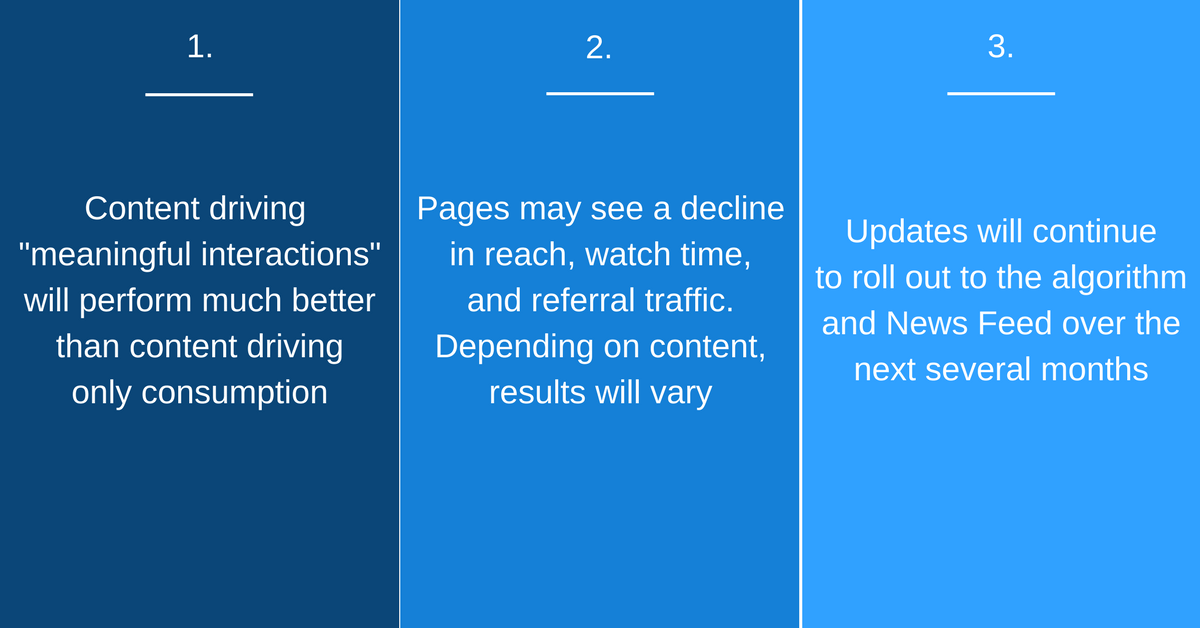
Let’s dive into a few actionable takeaways for brands!
What brands can do to succeed on Facebook
We know that, as brands, we need to focus on meaningful interactions. But what does that look like in action? Here are a few ways to ensure that your Page finds success in 2018.
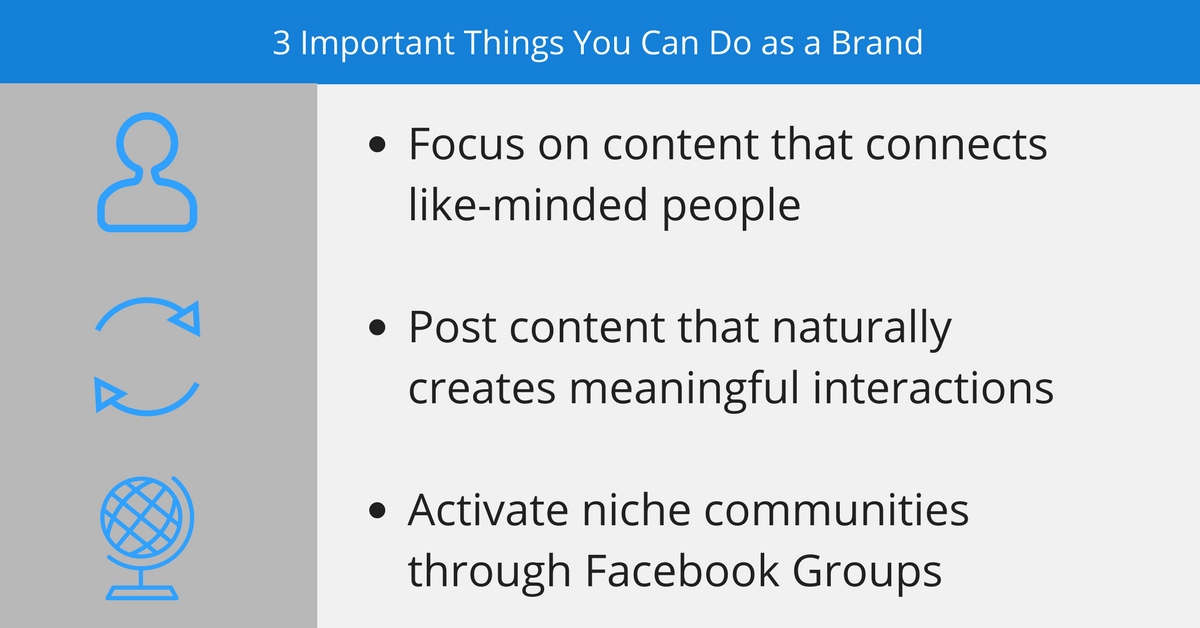
1. Focus on content that connects people
Focusing on content that connects people through meaningful interactions may look and feel similar to your current Facebook strategy, but it’s a fundamental shift in how we might approach content moving forward.
Instead of creating content, for your brand, that people interact with, we need to start creating content, for the people, that will spark enough emotion to generate a comment or share.

Creating content for the people requires us to truly understand our audience on a deep level:
- What are your audience’s challenges?
- What are your audience’s motivations?
- What does your audience love to interact with?
- What does your audience care about?
At Buffer, for example, I’ve found that our audience cares deeply about improving their marketing and social media skills in an actionable way. That simple piece of knowledge helps to guide every single piece of content we create for social media.
From videos:
To links to our blog:
Each piece of content that we share to Facebook serves a specific purpose: sparking emotion in our target audience so that they feel compelled to comment on or share our content with someone who might also find it interesting.
2. Post content that naturally creates meaningful interactions
There are some types of content that naturally spark more meaningful interactions among users. Video is one of those types of content, and it can have a powerful impact on your Facebook success.
In the recent Facebook News Feed update, Adam Mosseri provided an eye-opening stat:
“Live videos often lead to discussion among viewers on Facebook–in fact, live videos on average get six times as many interactions as regular videos. Many creators who post videos on Facebook prompt discussion among their followers, as do posts from celebrities”
Produced videos already perform better than both links and images in terms of engagement on Facebook, and now Facebook Live videos perform better than everything!
Check out this awesome example of Facebook Live video from Kohl’s where they teamed up with Tone It Up to bring viewers an interactive workout:
This video sparked more than 36,000 views, 115 comments, and 80 shares all while providing their audience with a memorable experience.
3. Activate niche communities through Facebook Groups
More than one billion people around the world use Facebook Groups. And more than 100 million people see Groups as the most important part of their experience on Facebook.
Groups are the perfect way to build an active and engaged community around topics, issues, and causes that they care about. Whether it’s social media marketing, traveling, fashion, or anything else, there’s a huge group of people out there waiting to connect with like-minded people.
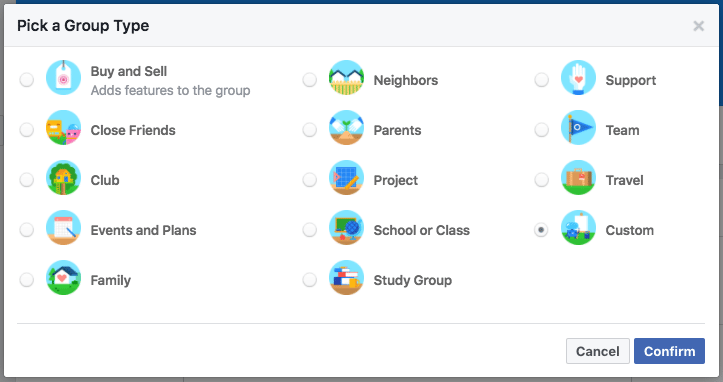
The real secret to Facebook Groups is the fact that they generate conversations among your audience and connect people from all over the world.
That’s why we’ve seen such a dramatic rise in the usage of groups and messaging apps over the past several years. In the sea of News Feed content, groups and message apps offer people a more private and personal way to share their thoughts, ideas, and opinions.
By creating a Facebook Group for your community, you are providing an open space where people can collaborate.
Over to you
It sure is an exciting time in the world of Facebook!
I truly believe that the recent changes to the Facebook algorithm are a good thing for both users and brands in the long run.
Now is a perfect time to hone in on your Facebook strategy and work to develop meaningful content and an engaged community. With time and patience, I am sure you will continue to find success with your Page.
I’d love to hear any thoughts or questions you might have, too!
Feel free to drop us a comment below anytime.
Try Buffer for free
140,000+ small businesses like yours use Buffer to build their brand on social media every month
Get started nowRelated Articles

In this article, I’ll explain what SEO is for social media, why you should care about it, and how you can use it to your advantage.
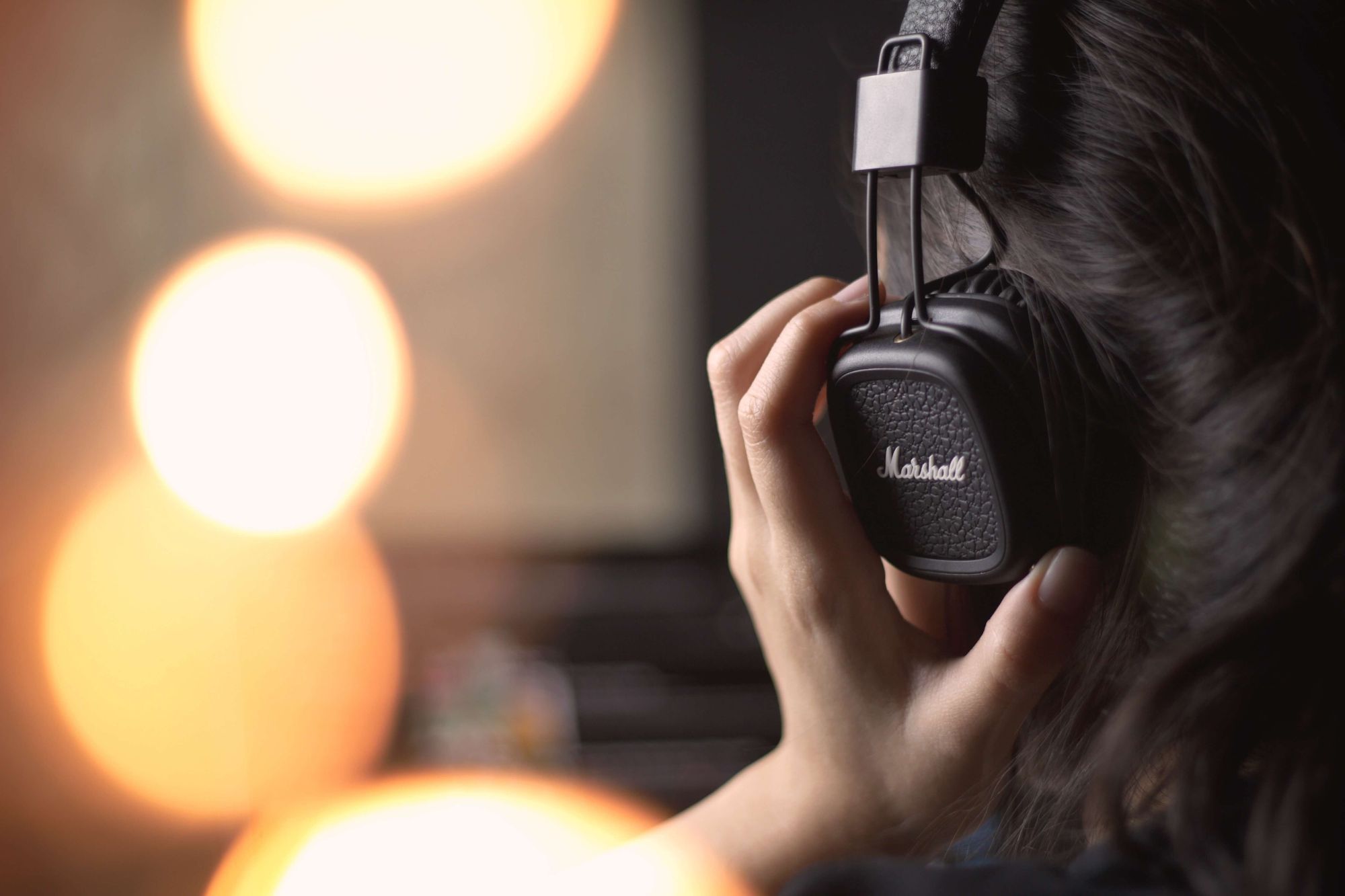
How to source the best audio clips for your TikToks while they’re still popular, plus examples of TikTok sounds with staying power.

This article looks into social media benchmarks for various industries and platforms.